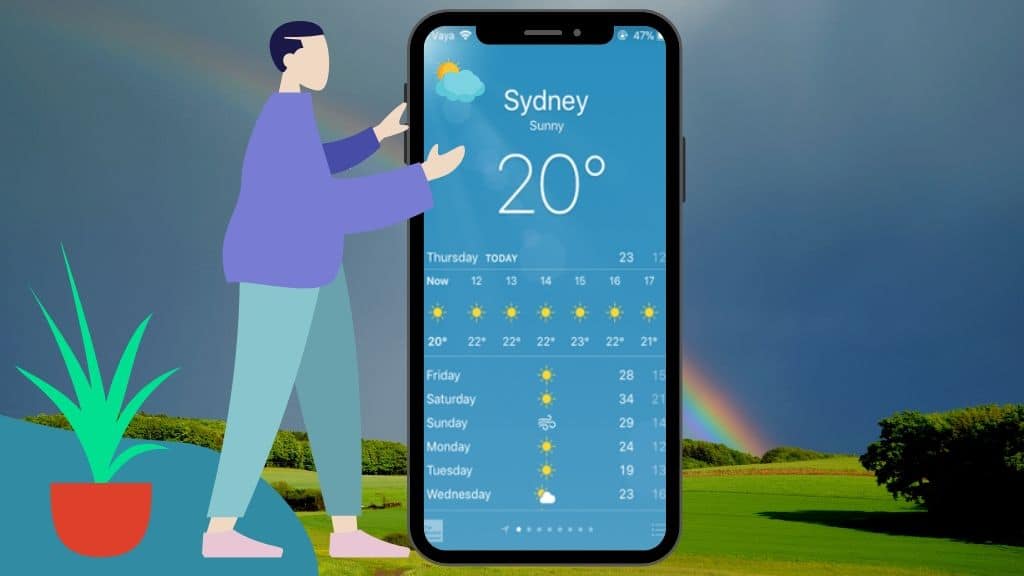WillyWeather has become a go-to weather application for many, known for its detailed forecasts, interactive radar maps, and a wealth of weather-related data. If you’re considering developing a similar weather app, understanding the costs involved is crucial. This blog post will delve into the various factors that influence the development cost of a weather app like WillyWeather.
Features that Define WillyWeather
Before estimating the cost, it’s essential to understand the features that make WillyWeather stand out. These typically include:
- Detailed Weather Forecasts: Including temperature, precipitation probability and intensity, wind speed and direction, humidity, and pressure, often extending for several days. WillyWeather provides 6-7 day forecasts tailored to specific locations.
- Interactive Radar and Satellite Maps: Displaying real-time rain radar and cloud cover, often integrated with map services for easy navigation. WillyWeather uses raw data from meteorological agencies like the Bureau of Meteorology (BoM) in Australia and NOAA in the US, refining and integrating it with map interfaces.
- Tide, Swell, and UV Forecasts: Providing specific information relevant to coastal areas, including tide times, swell height and direction for beaches, and hourly UV index forecasts with alerts. WillyWeather prides itself on a comprehensive tide system, incorporating data from national tide tables and marine agencies.
- Wind Forecasts: Utilizing global wind forecast models, interpolated for precise locations and often vetted against real-time observations.
- Moon Phases and Sunrise/Sunset Times: Including illumination percentages and rise/set times, often integrated with tidal data.
- Real-time Observational Data: Showing current temperature, feels-like temperature, rainfall in the last hour and today, humidity, pressure, wind details, and dew point.
- Severe Weather Warnings: Providing easily accessible warnings targeted to affected locations from meteorological agencies.
- Customizable Interface: Allowing users to save favourite locations and personalize the displayed weather information.
- Interactive Graphs: For tide, swell, and wind forecasts, offering a visual representation of conditions over time.
- Notifications and Alerts: For significant weather changes or severe conditions.
Factors Influencing Development Cost
Developing a feature-rich weather app like WillyWeather involves several key factors that significantly impact the overall cost:
- Complexity and Features: The more features and the more complex they are, the higher the development cost. Basic weather apps with simple forecasts will cost less than those with interactive maps, real-time data processing, and specialized forecasts like tides and UV.
- UI/UX Design: A visually appealing and user-friendly design is crucial for user engagement. Basic UI/UX will be less expensive than advanced designs with animations and custom interactions. WillyWeather is known for its beautiful, simple, and organized interface.
- Backend Development: A robust backend infrastructure is needed to handle large amounts of weather data, process it in real-time, and ensure scalability. More complex backend requirements will lead to higher costs. WillyWeather processes and fine-tunes forecast data to specific coordinates.
- Third-Party Integrations: Weather apps rely on APIs from meteorological services (like BoM, NOAA, AccuWeather, OpenWeatherMap), mapping services, and geolocation services. The cost of these integrations can vary based on usage limits and the number of services required. Some APIs have premium tiers with higher costs for more frequent data or advanced features.
- Platform (iOS, Android, or Cross-Platform): Developing native apps for both iOS and Android will be more expensive than developing for a single platform or using a cross-platform framework like Flutter or React Native. Cross-platform frameworks can potentially save costs by using a single codebase for both platforms.
- Technology Stack: The choice of programming languages, frameworks, and tools can influence the development cost. More advanced stacks might have higher initial costs but ensure better performance and scalability in the long run.
- Development Team: The size, experience, and location of the development team will significantly affect the cost. Hiring experienced developers or outsourcing to regions with different cost structures (e.g., India) can impact the budget. In India, the hourly rate for app developers can range from ₹1,010 to ₹21,000+ (approximately $12 to $250+ USD) depending on their experience level.
- Testing and Quality Assurance: Thorough testing is essential to ensure the accuracy of weather predictions and the app’s performance. Comprehensive testing will add to the development cost.
- Security: Implementing security measures to protect user data and ensure the app’s integrity is crucial and adds to the cost.
- Compliance: Depending on the region and the data used, there might be compliance standards and legal/licensing fees involved.
- Maintenance and Updates: Post-launch, the app will require maintenance, bug fixes, updates for new operating system versions, and potentially the addition of new features. These ongoing costs should be factored in (typically 15-20% of the initial development cost annually).
- App Hosting: Costs for hosting the app’s backend and data will depend on data storage, traffic, and cloud infrastructure requirements.
Estimated Development Costs
Based on the complexity and features similar to WillyWeather, the cost to develop such an app can vary significantly. Here’s a general breakdown based on complexity levels:
- Basic App: With standard weather updates and a simple UI, the cost could range from AUD 60,000 to AUD 122,000 (approximately $40,000 to $80,000 USD). In India, this might translate to ₹30,00,000 to ₹60,00,000.
- Moderately Complex App: Including features like radar maps, tide charts, and UV index, the estimated cost could be between AUD 122,000 and AUD 305,000 (approximately $80,000 to $200,000 USD). In India, this range might be ₹60,00,000 to ₹1,50,00,000.
- Advanced App: With AI-based nowcasting, real-time alerts, and a comprehensive set of features like WillyWeather, the cost could exceed AUD 305,000 to AUD 600,000+ (approximately $200,000 to $400,000+ USD) or more. For development in India, expect costs starting from ₹1,50,00,000 and potentially going upwards of ₹3,00,00,000.
Note: These are broad estimates, and the actual cost can vary depending on the specific requirements, the development team chosen, and other factors mentioned above. Developing for both iOS and Android natively would roughly double the development cost compared to a single platform. Opting for cross-platform development can potentially reduce the initial cost by 20-40%.
Cost Breakdown by Development Stages (Estimates in USD)
- Planning and Research: $5,000 – $10,000
- UI/UX Design:
- Basic: $5,000 – $10,000
- Advanced with animations: $10,000 – $40,000
- Backend Development:
- Basic setup: $5,000 – $30,000
- Advanced (real-time data processing): $30,000 – $80,000+
- Frontend Development (per platform): $7,500 – $30,000
- Third-Party Integrations:
- Basic API: $5,000 – $10,000
- Premium API: $10,000 – $30,000+
- Testing and Deployment: $3,000 – $20,000+
- Security Implementation:
- Basic: $5,000 – $10,000
- Advanced: $10,000 – $30,000+
- Compliance: $5,000 – $40,000+
Optimizing Development Costs
- Prioritize Essential Features: Start with a Minimum Viable Product (MVP) that includes core functionalities and gather user feedback before adding more complex features. This can reduce initial development costs significantly (by 20-50%).
- Choose Cross-Platform Development: If your target audience uses both iOS and Android, consider cross-platform frameworks to save time and resources (potential cost reduction of 20-40%).
- Outsource Strategically: Outsourcing to regions with competitive development rates, like India, can lead to significant cost savings (30-60% on hourly rates). However, ensure you choose a reliable and experienced team.
- Clear Requirements: Having well-defined requirements and specifications from the outset can prevent scope creep and unexpected costs.
- Effective Communication: Maintain clear and frequent communication with the development team to ensure the project stays on track and within budget.
Conclusion
Developing a weather app with the depth and features of WillyWeather requires a significant investment of time and money. The exact cost will depend on a multitude of factors, including the complexity of features, design quality, platform choice, and the development team’s location and expertise. By carefully planning your app’s features, considering cross-platform options, and potentially exploring outsourcing, you can optimize your development costs while still aiming to create a high-quality and user-engaging weather application. Remember to also budget for ongoing maintenance and updates to ensure the long-term success of your app.
In case you are looking to hire mobile app development company in Sydney , you may contact us .




